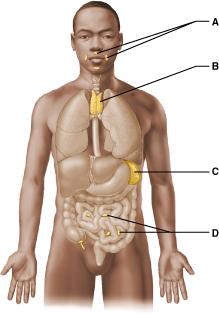
Which of these lymphoid organs destroys bacteria before it can breach the intestinal wall and generates "memory" lymphocytes for long-term memory? Select from letters A-D.
A
B
C
D
D
True and False:
Chyle is delivered to the blood via the lymphatic system.
True
Which of the following statements is true regarding veins versus lymphatic collecting vessels?
Veins and lymphatic vessels have a different number of tunics.
Veins have thinner walls than do lymphatic vessels.
Veins tend to form more branches (anastamoses) than do lymphatic vessels.
Veins have fewer internal valves than do lymphatic vessels.
Veins have fewer internal valves than do lymphatic vessels.
Which of the following lymphoid tissues/organs does NOT contain reticular connective tissue?
lymph nodes
spleen
tonsils
thymus
Thymus
When the lymphatic structures of a limb are blocked due to tumors, the result is ________.
severe localized edema distal to the blockage of that limb
abnormally high lymph drainage from the distal region
increased pressure in the lymphatics proximal in the limb to the blockage
shrinkage of tissues distal in the limb to the blockage due to inadequate delivery of lymph
severe localized edema distal to the blockage of that limb
Which of the following lymphoid cells secrete antibodies?
T lymphocytes
plasma cells
macrophages
dendritic cells
Plasma cells
Which of the following is not a normal component of lymph?
ions
red blood cells
plasma proteins
water
Red blood cells
Which of the following is NOT a lymphoid tissue/organ?
bone marrow
tonsils
Peyer's patches
spleen
Bone marrow
Once collected, lymph is returned to __________.
the liver for detoxification
venous circulation
the kidneys for filtration
arterial circulation
Venous circulation
Which of the following is not a part of the lymphatic system?
lymphatic vessels
lymph
lymph nodes
erythrocytes
Erythrocytes
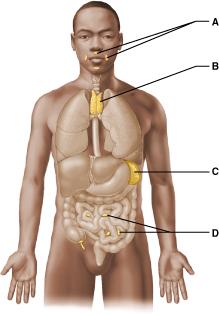
Which lymphoid organ extracts aged and defective blood cells and platelets from the blood in addition to storing some of the breakdown products for later reuse? Select from letters A-D.
A
B
C
D
C
The __________ is (are) the most likely to become infected.
lingual tonsil
palatine tonsils
pharyngeal tonsil
tubal tonsil
Palatine tonsils
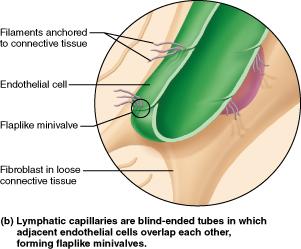
Which of the following lacks lymph capillaries?
loose connective tissues
skin
small intestine
bones and teeth
Bones and teeth
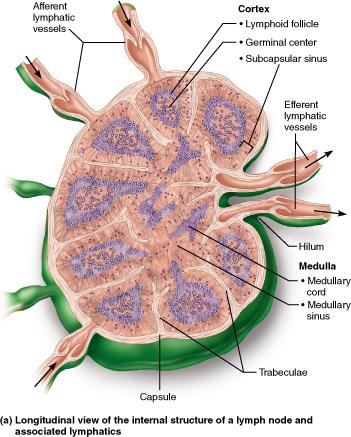
Lymph nodes are surrounded by a capsule from which connective tissue strands extend inward to divide the node into compartments. What is the name of these strands?
lymph sinuses
trabeculae
medullary cords
hilum
Trabeculae
Where is the spleen located?
left side of the abdominal cavity just beneath the diaphragm and curled around the anterior aspect of the stomach
clusters of lymphoid follicles located in the wall of the distal portion of the small intestines
forming a ring of lymphoid tissue around the entrance to the pharynx (throat)
inferior neck and extending into the superior thorax, partially overlying the heart deep to the sternum
left side of the abdominal cavity just beneath the diaphragm and curled around the anterior aspect of the stomach
Which of the following is NOT a lymphatic cell?
dendritic cell
eosinophil
macrophage
reticular cell
Eosinophil
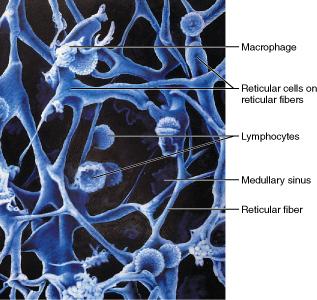
What type of tissue is commonly found in all lymphoid organs and tissues (except the thymus)?
elastic cartilage connective tissue
elastic connective tissue
reticular connective tissue
areolar connective tissue
reticular connective tissue
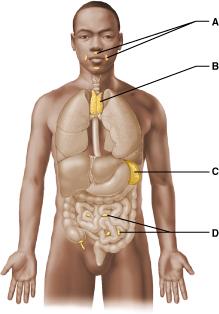
Which lymphoid organ is primarily active during the early years of life? Select from letters A-D.
A
B
C
D
B
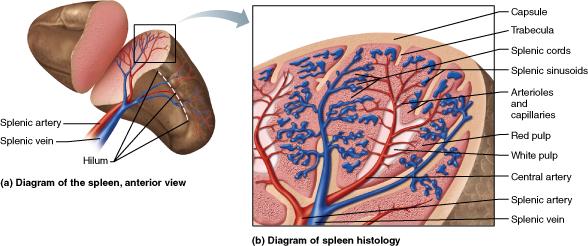
Where are worn-out erythrocytes found in the spleen?
splenic cords
red pulp
capsule
white pulp
Red pulp
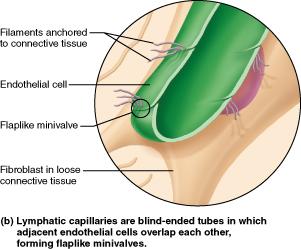
What is the main function of the lymphatic system?
The lymphatic system regulates blood pressure through the renin-angiotensin-aldosterone mechanism.
The lymphatic system returns leaked fluid and plasma proteins that escape from the bloodstream to the blood.
The lymphatic system pumps and transports blood throughout the body.
The lymphatic system makes blood cells through a process known as hematopoiesis.
The lymphatic system returns leaked fluid and plasma proteins that escape from the bloodstream to the blood.
Antibodies are produced by __________.
reticular cells
macrophages
dendritic cells
plasma cells
Plasma cells
True or False:
The lymphatic capillaries function to absorb the excess protein-containing interstitial fluid and return it to the bloodstream.
True
Select the correct statement about lymph transport.
Lymph transport is only necessary when illness causes tissue swelling.
Under normal conditions, lymph vessels are very high-pressure conduits.
Lymph transport is faster than that occurring in veins.
Lymph transport depends on the movement of adjacent tissues, such as skeletal muscles.
Lymph transport depends on the movement of adjacent tissues, such as skeletal muscles
True or False:
When tissues are inflamed, lymphatic capillaries develop openings that permit uptake of large particles such as cell debris, pathogens, and cancer cells.
True
Lymph is most similar to __________.
interstitial fluid
blood plasma
saliva
water
Interstitial fluid
True or False:
Some immunocompetent cells will never be called to service in our lifetime.
True
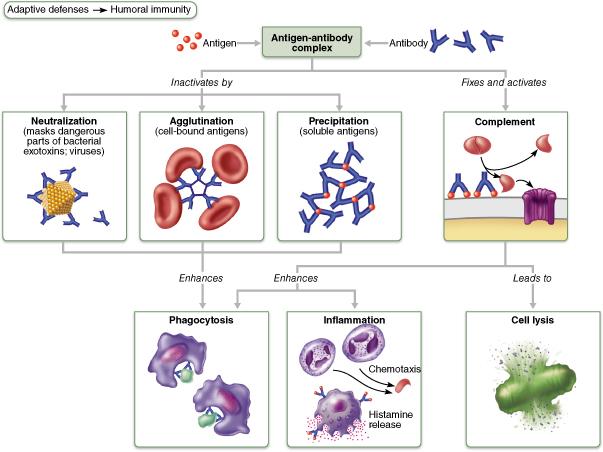
Which mechanism of antibody action results in cell lysis?
agglutination
complement fixation and activation
precipitation
neutralization
Complement fixation and activation
True or False:
Cellular ingestion and destruction of particulate matter is called phagocytosis.
True
Which of the following do NOT serve as antigen-presenting cells (APC)?
B cells
natural killer cells
macrophages
dendritic cells
Natural killer cells
True or False :
Adaptive immunity is provided only by lymphocytes that secrete antibodies.
False
The process whereby neutrophils and other white blood cells are attracted to an inflammatory site is called ________.
phagocytosis
chemotaxis
diapedesis
margination
Chemotaxis
What is the role of interferon in defense against disease?
activates the complement mechanism
activates the inflammatory process
protects cells that have not yet been infected by viruses
to kill the bacteria
Protects cells that have not yet been infected by viruses
Immunocompetence ________.
prevents intercellular communication so that only specific cell types respond to the invader
is the ability of individual cells to recognize a specific antigen by binding to it
occurs in one specific organ of the adaptive immune system
requires exposure to an antigen
is the ability of individual cells to recognize a specific antigen by binding to it
True or False:
Substances capable of triggering the adaptive immune system and provoking an immune response are called antigens.
True
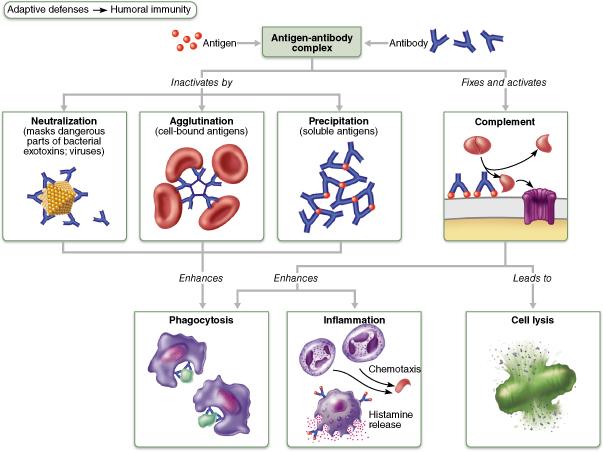
Which of the following mechanisms of antibody action occur when red blood cells clump due to a transfusion of mismatched blood?
agglutination
complement fixation and activation
neutralization
precipitation
Agglutination
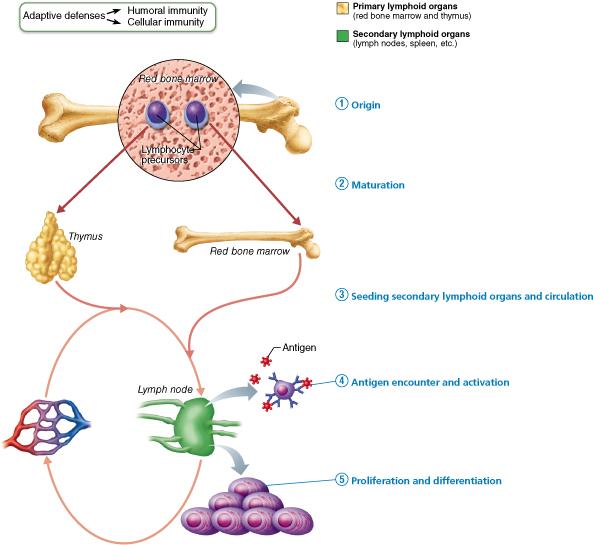
Which cells mature in the thymus?
memory cells
T cells
effector cells
B cells
T cells
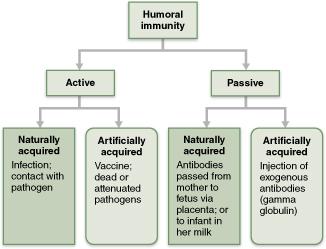
Which of the following best illustrates artificially acquired active humoral immunity?
infection
vaccines
antibodies received in breast milk
antivenoms
Vaccines
Which of the following is not a function of the inflammatory response?
replaces injured tissues with connective tissue
prevents the spread of the injurious agent to nearby tissue
sets the stage for repair processes
disposes of cellular debris and pathogens
Replaces injured tissues with connective tissue
__________ immunity protects a baby who is fed breast milk.
Artificial passive
Natural passive
Natural active
Artificial active
Natural passive
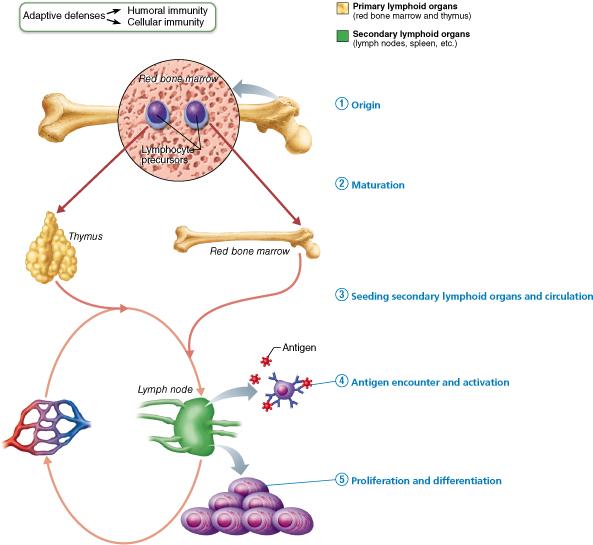
How does a lymphocyte become immunocompetent?
Lymphocytes rapidly proliferate to form an army of cells exactly like themselves and bearing the same antigen-specific receptors.
Lymphocytes must be able to recognize their one specific antigen by binding to it.
An antigen binds to a particular lymphocyte that has a receptor for it.
Lymphocytes must be relatively unresponsive to self-antigens so that they do not attack the body's own cells.
Lymphocytes must be able to recognize their one specific antigen by binding to it.
True or False:
Fever is seldom beneficial because it speeds up the cellular metabolic rate and will not allow antigen-antibody reactions to occur.
False
__________ are lymphocytes that directly kill virus- infected cells.
Macrophages
B cells
Cytotoxic T cells
Helper T cells
Cytotoxic T cells
Antigens bound to MHC II activate __________.
macrophages
cytotoxic T cells
helper T cells
B cells
Helper T cells
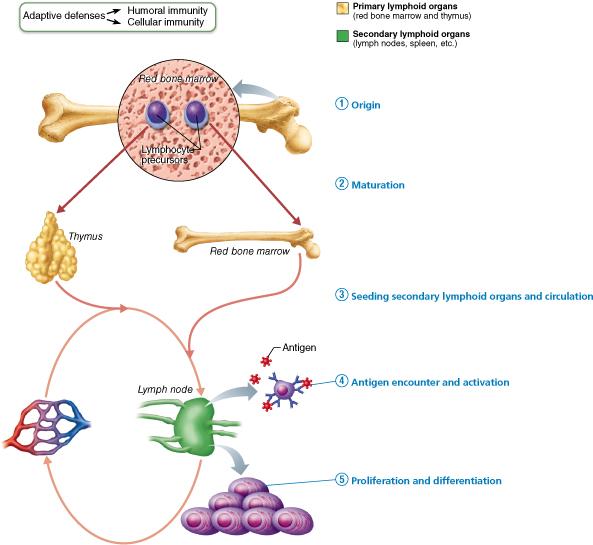
What are B and T cells called that have not yet been exposed to an antigen?
self-tolerant
naive
clone
immunocompetent
Naive
Which defense mechanism results in redness, heat, pain, and swelling?
antibody production
phagocytosis
inflammation
cell-mediated immunity
Inflammation
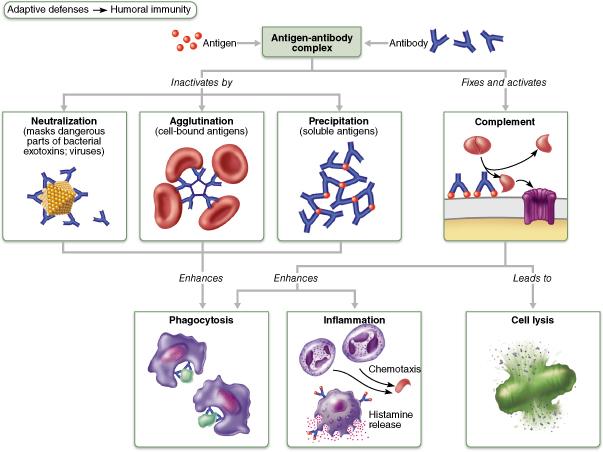
Which mechanism occurs when antibodies block specific sites on viruses or bacterial exotoxins?
neutralization
agglutination
precipitation
complement fixation and activation
Neutralization
Which of the following is an effect of complement activation?
T cell activation
tissue repair
opsonization
fever
Opsonization
Which of the following is (are) NOT a part of the innate immune defenses?
inflammation
T cells
fever
natural killer (NK) cells
T cells
What mobilizes the adaptive defenses and provokes an immune response?
antigens
MHC proteins
pyrogens
interferons
Antigens
Cancer cells and virus-infected body cells can be killed before activation of adaptive immunity by ________.
pinocytosis
B lymphocytes
natural killer cells
T lymphocytes
Natural killer cells
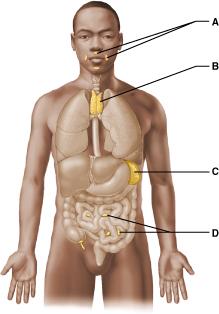
Which of these lymphoid organs is the thymus? Select from letters A-D.
A
B
C
D
B
True or False:
There are more efferent lymphatic vessels leaving a lymph node than there are afferent vessels entering a lymph node.
False
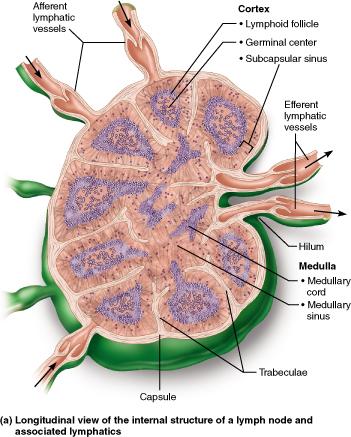
The filtration of lymph and immune system activation are the two basic functions of the __________.
lymph nodes
tonsils
spleen
Peyer's patches
Lymph nodes
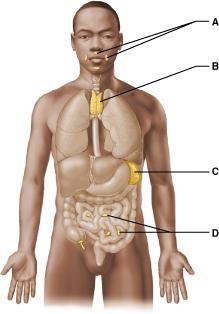
Which of these lymphoid organs is a part of collection of tissues called the mucosa-associated lymphoid tissues (MALT) and removes pathogens entering the pharynx (throat)? Select from letters A-D.
A
B
C
D
A
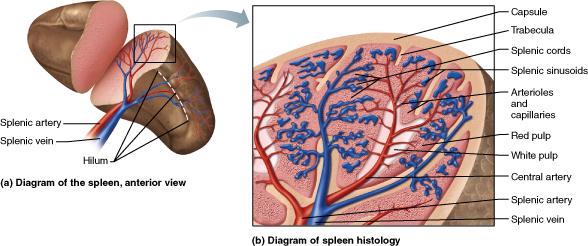
Which part of the spleen is the site of immune function?
red pulp
white pulp
splenic cords
splenic sinusoids
White pulp
Lymph capillaries are absent in all except which of the following?
bone marrow
bones and teeth
CNS
digestive organs
Digestive organs
True or False:
Like blood, lymph flows both to and from the heart
False
Which of the following is a role of lymph nodes?
They filter lymph.
They produce red blood cells.
They
return lymph to circulation.
They produce lymph.
They filter lymph
Select the correct statement about lymphocytes.
B cells produce plasma cells, which secrete antibodies into the blood.
T cells are the precursors of B cells.
T cells are the only form of lymphocyte found in lymphoid tissue.
The two main types are T cells and macrophages.
B cells produce plasma cells, which secrete antibodies into the blood.
True or False:
Because lymph vessels are very low-pressure conduits, movements of adjacent tissues are important in propelling lymph through the lymphatics.
True
True or False:
The directional movement of cells in response to chemicals is called chemotaxis.
True
B lymphocytes develop immunocompetence in the ________.
lymph nodes
bone marrow
thymus
spleen
Bone marrow
True or False:
Virus infected cells secrete complement to "warn" other cells of the presence of virus.
False
Which of the following is a part of the second line of defense against microorganisms?
gastric juice
keratin
phagocytes
cilia
Phagocytes
Which of the following is not characteristic of the adaptive immune system?
It is specific for a given organ.
It has memory.
It is
antigen-specific.
It is systemic.
It is specific for a given organ.
Innate immune system defenses include ________.
phagocytosis
T cells
B cells
plasma cells
Phagocytosis
Which of the following statements regarding NK cells is a false or incorrect statement?
NK cells attack cancer cells and virus-infected body cells.
NK cells attack cells that display abnormal MHC antigens.
NK cells are present in the blood, spleen, lymph nodes, and red bone marrow.
NK cells are a type of neutrophil.
NK cells are a type of neutrophil.
Complement proteins and antibodies coat a microorganism and provide binding sites, enabling macrophages and neutrophils to phagocytize the organism. This phenomenon is termed ________.
opsonization
agglutination
diapedesis
chemotaxis
Opsonization
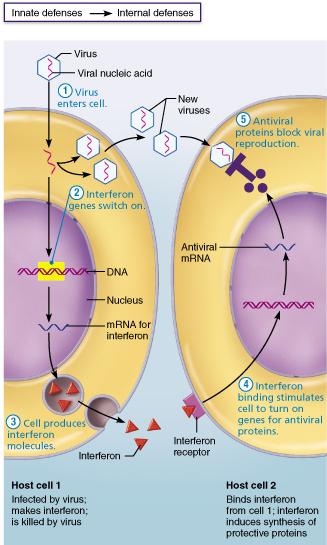
How do interferons protect against infection in healthy cells?
Interferons perform complement activation.
Interferons promote fever, or an abnormally high body temperature.
Interferons perform opsonization to coat microorganisms.
Interferons block viral reproduction in healthy cells through the production of antiviral proteins.
Interferons block viral reproduction in healthy cells through the production of antiviral proteins.
What is the specific target of interferons?
specific viruses
antibodies
infected cells
nearby
healthy cells
Nearby healthy cells